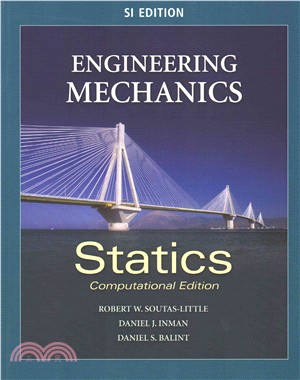ENGINEERING MECHANICS: STATICS-COMPUTATIONAL SI EDITION
商品資訊
ISBN13:9780495438113
出版社:Cengage Learning
作者:SOUTAS-LITTLE
出版日:2008/01/01
裝訂:平裝
商品簡介
作者簡介
Robert W. Soutas-Little
Robert W. Soutas-Little received his Ph.D. from the University of Wisconsin in 1962 and is now a Professor Emeritus in the Departments of Mechanical Engineering and Materials Science and Mechanics at Michigan State University. Author to 6 books on the topics of Elasticity, Engineering Mechanics, Statics, and Dynamics, Dr. Soutas-Little has also published over 60 journal papers and chapters in books as well as co-authoring 15 technical reports. He has Directed 22 PhD’s as well as 150 M.S. Students and prior to teaching at Michigan State he held positions at Oklahoma State University, University of Wisconsin, Marquette University, Technion in Israel, and a MSU summer program at Cambridge University, England. He is a Founding Member of the American Society of Biomechanics, a Charter Member or the Society of Engineering Science, a Member of the International Society of Biomechanics, the American Society of Mechanical Engineering, and the American Association for the Advancement of Science. Dr. Soutas-Little has been the recipient of the Western Electric Award for Teaching Excellence in Engineering in 1970, the Goldberg Chair in 1982, the Distinguished Faculty Award – Michigan State University in 1995, named a Fellow of the American Society of Mechanical Engineers in 1996, received the Withrow Teaching Excellence Award in 1997, the Withrow Distinguished Scholar Award in 1999, as well as receiving many research contracts and grants between 1962 and 1999. His research interests include Biomechanics, Dynamics, Applied Mathematics, Elasticity, and Continuum Mechanics.
Daniel J. Inman
Daniel J. Inman received his Ph.D. from Michigan State University in Mechanical Engineering in 1980 and is the Director of the Center for Intelligent Material Systems and Structures and the G.R. Goodson Professor in the Department of Mechanical Engineering at Virginia Tech. Since 1980, he has published six books (on vibration, control, statics, and dynamics), eight software manuals, 20 book chapters, over 195 journal papers and 380 proceedings papers, given 34 keynote or plenary lectures, graduated 45 Ph.D. students and supervised more than 65 MS degrees. He is a Fellow of the American Academy of Mechanics (AAM), the American Society of Mechanical Engineers (ASME), the International Institute of Acoustics and Vibration (IIAV), and the American Institute of Aeronautics and Astronautics (AIAA). He is currently Technical Editor of the Journal of Intelligent Material Systems and Structures (1999- ), Technical Editor of the Shock and Vibration Digest (1998- ), and Technical Editor of the journal Shock and Vibration (1999- ). He has served as Technical Editor of ASME Journal of Vibration and Acoustics (1990-1999), and as Associate Editor of the following: ASME Journal of Vibration and Acoustics (1986-89), ASME Journal of Applied Mechanics (1988-94), Mechanics of Machines and Structures (1986-98), International Journal of Analytical and Experimental Modal Analysis (1986-1990) and Journal of Intelligent Material Systems and Structures (1992-1999) and Smart Materials and Structures (1991-2001). He is a founding member of the ASME Adaptive Structures and Material Systems Technical Committee and the AIAA Adaptive Structures Technical Committee. He won the ASME Adaptive Structures Award in April 2000, the ASME/AIAA SDM Best Paper Award in April 2001, the SPIE Smart Structures and Materials Life Time Achievement Award in March of 2003, the ASME Best Paper in Adaptive Structures in 2007, and the ASME Den Hartog Award in 2007
Daniel S. Balint
Daniel S. Balint received his PhD in Engineering Science from Harvard University in 2003. He is currently a Lecturer on Structural Integrity for the Department of Mechanical Engineering at Imperial College London. He is co-author to 10 textbooks and supplements on the topic of Engineering Mechanics as well as co-author of 14 journal articles. Dr. Balint is a member of The Scientific Research Society, the American Society of Mechanical Engineers, and the Golden Key International Honor Society. During his academic career he received 10 awards including the Harvard University Certificate of Distinction in Teaching – 2001, and the National Defense Science and Engineering Graduate Fellowship – 1998. His areas of research interest include discrete dislocation modeling, size effects in materials, failure in thermal barrier coatings and functionally graded materials, thin film delamination and fracture, multiscale modeling of elastic/plastic fracture, computational techniques in solid mechanics, and orthopedic biomechanics.
目次
Chapter 1 Introduction 1
1.1 Mechanics
1.2 Basic Concepts
1.3 Units
1.3.1 SI Units
1.3.2 Customary Units
1.3.3 Conversion between Systems of Units
1.4 Numerical Calculations
1.5 Problem-solving Strategy
1.6 Computational Software
Chapter 2 Vector Analyis
2.1 Introduction
2.2 Vectors
2.2.1 Definition of a Scalar and a Vector
2.2.2 Vector Addition
2.2.3 Multiplication of a Vector by a Scalar
2.2.4 Vector Components
2.2.5 Resolution of a Vector into Components
2.3 Forces and Their Characteristics
2.3.1 Concurrent Coplanar Forces
2.4 Three-dimensional Cartesian Coordinates and Unit Base Vectors
2.4.1 Unit Base Vectors
2.4.2 Vector Equality in Component Notation
2.4.3 Vector Addition by Components
2.4.4 Multiplication of a Vector by a Scalar
2.4.5 Vector Subtraction
2.4.6 General Unit Vectors
2.4.7 Vector Directions in Space
2.4.8 Matrix Notation for Vectors
2.5 Computation of Vector Operations
2.6 Components of a Vector in Nonorthogonal Directions
2.7 Systems of Linear Equations
2.7.1 Matrices
2.8 Scalar Product of Two Vectors
2.8.1 Applications of the Scalar Product
2.9 Vector Product or Cross Product
2.9.1 Multiple Products of Vectors
2.10 Direct Vector Solutions
Chapter 3 Particle Equilibrium
3.1 Free-body Diagrams of a Particle
3.2 Equilibrium of a Particle
3.3 Springs
3.4 Statically Indeterminate Problems
3.5 Special Sections
3.5A Introduction to Friction
3.5B Keystone of the Arch
Chapter 4 Rigid Bodies: Equivalent Force Systems
4.1 Rigid Bodies
4.2 Modeling of Rigid Bodies and Moment of a Force
4.3 Moment of a Force about a Point in Space
4.3.1 Direct Vector Solutions
4.4 Varignon’s Theorem
4.5 Moment of a Force about an Axis
4.6 Moment of a Couple
4.7 Equivalent Force Systems
4.8 Special Equivalent Force Systems
4.8.1 Concurrent Force Systems
4.8.2 Coplanar Force Systems
4.8.3 Parallel Force Systems
4.9 General Equivalent Force Systems
4.9.1 The Wrench 160
Chapter 5 Distributed Forces: Centroids and Center of Gravity
5.1 Introduction
5.2 Center of Mass and Center of Gravity
5.2.1 Center of Mass
5.2.2 Center of Gravity
5.3 Average Position: Centroids of Areas, Volumes, and Lines;The First Moment
5.3.1 Centroid of an Area
5.3.2 Centroid of a Volume
5.3.3 Centroid of a Line
5.3.4 Centroid of a Curve in Space
5.4 Theorems of Pappus and Guldinus
5.5 Centroids of Composite Bodies
5.6 Distributed Loads on Beams
5.7 Forces Due to Fluid Pressure Acting on a Submerged Surface
5.7.1 Buoyancy
Chapter 6 Equilibrium of Rigid Bodies
6.1 Introduction
6.2 Supports for a Two-dimensional Model
6.3 Supports for a Three-dimensional Model
6.4 Free-body Diagram
6.5 Equilibrium of a Rigid Body in Two Dimensions
6.5.1 Solution Strategy
6.5.2 A Two-Force Member
6.5.3 A Three-Force Member
6.6 Equilibrium of a Rigid Body in Three Dimensions
6.6.1 Constraints
6.7 Statically Indeterminate Reactions and Improper Constraints
Chapter 7 Analysis of Structures
7.1 Introduction
7.2 Planar Trusses
7.3 Simple Trusses
7.4 Method of Joints
7.5 Method of Joints Using Matrix Techniques
7.6 Method of Sections
7.7 Space Trusses
7.8 Compound Trusses
7.9 Frames and Machines
Chapter 8 Internal Forces in Structural Members
8.1 Introduction
8.2 Internal Forces in a Member
8.3 Types of Loading and Supports in Beams
8.4 Shear and Bending Moments in Beams
8.4.1 Relationship between the Load Distribution, the Shear Force, and the Bending Moment
8.5 Discontinuity Functions for Beam Equations
8.6 Cables
8.6.1 Cable Subjected to Concentrated Loads
8.6.2 Cables Supporting Loads Distributed Uniformly along a Horizontal Line
8.6.3 Cable Supporting Loads Distributed Uniformly along its Own Length
Chapter 9 Friction
9.1 Introduction
9.2 Coulomb Friction
9.3 Wedges
9.4 Square-Threaded Screws
9.5 Belt Friction
9.5.1 V-belts
9.6 Bearings
9.7 Thrust Bearings, Collars, and Clutches
9.8 Rolling Resistance
Chapter 10 Moments of Inertia
10.1 Introduction
10.2 Second Moment of an Area
10.2.1 Determination of the Second Moment of an Area by Integration
10.3 Polar Moment of Inertia
10.4 Second Moment of an Area about Centroidal Axes for Specific Areas
10.5 Parallel-Axis Theorem for the Second Moment of Area
10.6 Radius of Gyration of an Area
10.7 Second Moments of Composite Areas
10.8 Principal Second Moments of Area
10.8.1 Product Moment of an Area, or Product Moment of Inertia
10.8.2 Rotation of Axes
10.9 Mohr’s Circle to Determine Principal Second Moments of Area
10.10 Eigenvalue Problem
10.11 Mass Moments of Inertia
10.11.1 Parallel-Axis Theorem
Chapter 11 Virtual Work
11.1 Introduction
11.1.1 Work—By a Force or Moment
11.2 Virtual Work
11.3 Principle of Virtual Work for a System of Connected Rigid Bodies
11.4 Finite Work of a Force and Moment
11.5 Conservative Forces and Potential Energy
11.6 Potential Energy and Equilibrium
11.7 Stability of Equilibrium
Appendix
Solution of Systems of Linear Equations
Gauss–Jordan Reduction
Inverse of a Matrix
Solution of Vector Equations
Statics Index Dictionary
Answers
Index
主題書展
更多書展今日66折
您曾經瀏覽過的商品
購物須知
為了保護您的權益,「三民網路書店」提供會員七日商品鑑賞期(收到商品為起始日)。
若要辦理退貨,請在商品鑑賞期內寄回,且商品必須是全新狀態與完整包裝(商品、附件、發票、隨貨贈品等)否則恕不接受退貨。
























